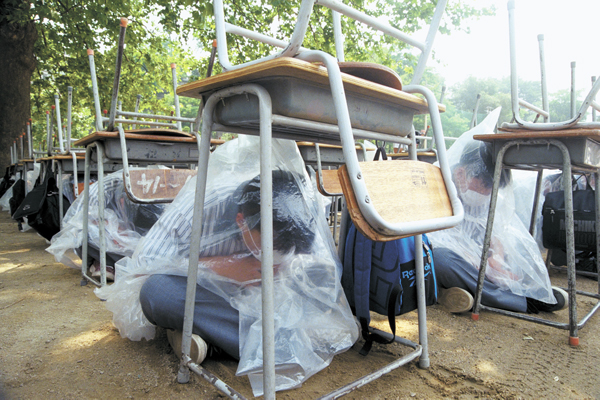Some lax attitudes spill over into civilian drills

Koreans have been practicing civil-defense and disaster evacuation drills since 1951, but experts say the nationwide drill is not practical. Above: In 1997, high school students participate in a civil defense drill. Today’s students do the same thing on the 15th of every month. [JoongAng Ilbo]
“I looked out the window and saw the streets were all empty,” said Shin Yoon-jeong, an office worker in the Sangam-dong area, which is home to several broadcasting companies.
“I thought something was going on, but I didn’t really know what it was so I kept working inside the building.”
The Eulji Drill took place between Aug. 18 and 21 across the nation.
The general population and companies in the service industry, such as theaters, department stores and big-box chain stores, are meant to take part in the civil defense training, but a majority didn’t.
After the Sewol sinking in April, Koreans are more interested in learning about survival tips than ever before, but they are still passive about the regular civil defense drills.
Apart from the Eulji Drill, which is an annual event, there is another type of civil-defense and disaster evacuation exercise - the minbangwi, which takes place on the 15th of every month. The nationwide drill began in January 1951.
There are two minbangwi drills. The first is for ordinary citizens. On the day of the drill, everyone should evacuate to safe places, for example on ground levels or under protective covering such as tables or chairs, when the siren is turned on.
The other is for men aged between 17 and 50 who have finished their military duties. Men in this group must attend 50 hours of training per year, where they watch videos that teach them how to defend their communities. People who dodge the training face fines of 100,000 won ($98).
“I consider the mandatory minbangwi drill as time to sleep,” said a man in his late 30s who didn’t want to be identified. “Nobody thinks of it seriously.”
But why do people have lax safety attitudes in regards to this drill?
“As we all know, the minbangwi drill is a nationwide thing - only a few people take part in it. Since coverage is so wide, it is regarded as good for nothing,” Cho Won-cheol, a professor of civil and environmental engineering at Yonsei University, told Newsis, a local news wire service provider, in May.
“The drill has to be more tangible and practical than it is now,” Cho continued. “For example, people need to know the location of evacuation shelters in their neighborhood, and they have to visit the shelter as part of the drill.”
Choi Chung-su, an official working at the National Emergency Management Agency’s minbangwi department, also admitted they have a hard time involving businesses in the regular drills.
“Service industries like department stores, theaters and express bus terminals all have to join the drill, but they don’t for the most part because the drills directly influence sales,” he said.
For every hour of a drill, department stores lose 600 million won.
BY SUNG SO-YOUNG [so@joongang.co.kr ]










with the Korea JoongAng Daily
To write comments, please log in to one of the accounts.
Standards Board Policy (0/250자)